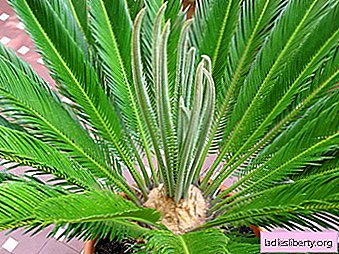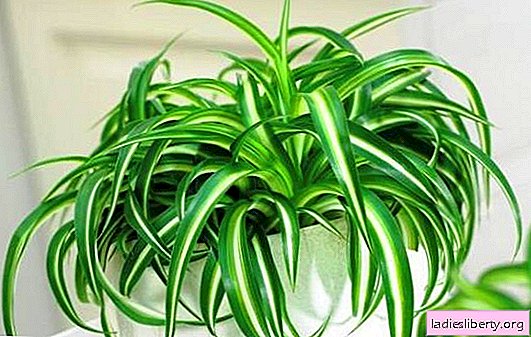
Cicas (Cycas) or, as it is also called, Cycas, belongs to the family of the Sagovnikovs and the genus Tsikas. His homeland is Australia and Southeast Asia. This is one of the oldest plants on our planet, the progenitor of modern species. The genus Tsikas is represented by approximately 20 species of palm-shaped plants, whose places of growth today are the Black Sea coast, Southeast Asia, Australia, as well as numerous islands of the Indian and Pacific Oceans.
At home, cicasses are used as a decorative material for flower arrangements and a food product, because its bark and core of the trunk contain up to 45% of starch. At the same time, cicada is a very ornamental plant widely used in landscaping, especially in countries with a hot climate. For decorative cultivation, only a few species are used. The most popular in the culture is the cicada drooping or bent (Cycas revoluta), which has a powerful columnar trunk, reaching up to 2.5 m tall, and an apical crown of leathery cirrus leaves. Cultivated species are also represented by curled cycas (Cycas circinalis), Tuar cicasus (Cycas thouarsii), Rumph cicasus (Cycas rumphii), combed cicasus (Cycas pectinata), media or medium cicasus (Cycas media), and non-ringed cicasus (Cycas inermis).
In Russia, Cycas can also be found growing in open ground, for example, in the Sochi region and on the Black Sea coast of the Caucasus. In the middle zone, they are grown as indoor and greenhouse plants.
Tsikas - growing and care
For cicas, the temperature regime is important. The most optimal for its maintenance in spring and summer is a temperature of 20-25 ° C. In autumn, it should begin to be gradually lowered, so that by the period of winter dormancy it was no higher than 12-14 ° C. If you do not provide a decrease in the temperature of the content of cicas in winter, it can lose leaves.
Tsikas is a light-loving plant, so you need to place it in places with bright lighting, direct sunlight is allowed. The best location for this plant would be the space at the southwest or southeast window. You can put a flower pot at the south window, but in summer it will have to be shaded from the sun. When a plant has new leaves, it cannot be rotated often, otherwise they may die. If there is such an opportunity, it is better to keep cicadas in the fresh air in summer.
Watering the plant should be careful, since overmoistening the soil is very dangerous for it. In summer, watering should be done 1 time in 5-7 days, in winter - 1 time in 10 days. When the content of cicas in the winter at room temperature, without a pronounced period of rest, it is necessary to provide watering, typical of summer time. Water the plant should be warm, settled for at least 12 hours with water.
Cycas is not particularly demanding on air humidity, however, if the room temperature exceeds 20 ° C, the pot with the plant must be kept on a pallet with wet gravel. Once a week, you need to spray the leaves to refresh them and wash off the dust.
In spring and summer, it is recommended to feed the cicasa once every 2 weeks, using a complete complex mineral fertilizer for this. However, its concentration should be taken half that which is indicated on the package. When the plant is in a dormant period, it should not be fertilized.
Tsikas - transplant and reproduction
The young plant should be replanted annually in the spring. After reaching the age of five, a transplant is performed every 3-4 years, but at the same time the top layer of the earth is changed annually. When replanting a plant, one should not shake and wash the roots from the ground, so as not to injure it. When planting and transplanting, the cone cone should be on the surface of the soil, so the pots should not be too large so that the plant does not die from the excess of undeveloped roots of the earth and its acidification.
For planting cicas, you should prepare a soil mixture, which includes turf, peat, leaf and humus land with the addition of sand. You can use ready-made soil mixture for palm trees for transplanting. When transplanting cicas, care should be taken about good drainage, which is made from small pebbles or broken shards.
The cicada is usually propagated by rooting young shoots - cones. Before planting, they are dried during the day and, sprinkled with cut coal places of cuts, are planted in the soil mixture for transplantation.
As a rule, only specialists in botanical purposes use the seed method of reproduction.
Tsikas - diseases and pests
If we assume that the cypress is on a draft or is waterlogged, then leaf spotting may appear.
At too low a temperature and excessive watering, rot develops on the roots of the plant, which can lead to the death of the root system. Then they turn brown and the leaves die, and then the whole plant dies. If root rot is detected, the cygnus plant is subject to destruction.
Also, cicas can be affected by pests, such as scale insects and thrips, which parasitize on its leaves, petioles and stem. This leads to the appearance of spots on the leaves, their drying and falling. To remove parasites, use a soft damp cloth, and with severe infection, the plant must be treated with karbofos or actellik.
Of course, cicada is a slowly growing, but very beautiful houseplant. In addition, it is believed that it has a beneficial effect on the functioning of the human nervous and cardiovascular systems. Therefore, it is worthwhile to work hard to grow this wonderful and mysterious plant in your home in your home.
Comments











